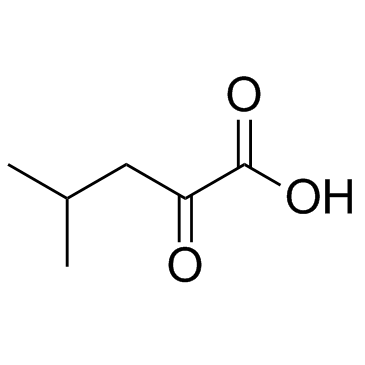4-Methyl-2-oxopentanoic acid (Synonyms: 2-Ketoisocaproate, α-Ketoisocaproate, 2-Ketoisocapronic Acid, KIC, 4-MOP, 2-Oxoisocaproic Acid, 4-methyl-2-Oxopentanoate, 4-methyl-2-Oxovaleric Acid, 4-methyl-2-Oxovalerate) |
| Catalog No.GC31307 |
비정상적인 대사산물인 4-Methyl-2-oxopentanoic acid(α-Ketoisocaproic acid)는 신경독인 동시에 대사독소입니다.
Products are for research use only. Not for human use. We do not sell to patients.

Cas No.: 816-66-0
Sample solution is provided at 25 µL, 10mM.
4-Methyl-2-oxopentanoic acid is an abnormal metabolite, a neurotoxin and a metabolic toxin. 4-Methyl-2-oxopentanoic acid increases endoplasmic reticulum stress, promotes lipid accumulation in preadipocytes and insulin resistance by impairing mTOR and autophagy signaling pathways[1] [2].
4-Methyl-2-oxopentanoic acid (0-300μM; 2d) treatment concentration-dependently increased lipid accumulation and the expression of lipogenic proteins, such as processed SREBP1 and SCD1, in 3T3-L1 preadipocytes[1]. 4-Methyl-2-oxopentanoic acid (1-10mM) reduced the HT-22 cells’ metabolic ability to reduce cytotoxicity and increased RS production in hippocampal neurons[2].
Mitochondrial complexes activities were reduced, and the formation of reactive species (RS) was increased in the hippocampus of rats after 4-Methyl-2-oxopentanoic acid (4mol/L, 2μL; ICV) administration[2].4-Methyl-2-oxopentanoic acid(10mmol/l; ICV) stimulated insulin secretion and elevated the NADPH/NADP+ ratio of islets preincubated in the absence of fuel[3].4-Methyl-2-oxopentanoic acid (400μmol/kg/h; carotid arch injection; single dose injection 60 min) increases porcine skeletal muscle protein synthesis and plasma leucine levels[4].
References:
[1].Park T J, Park S Y, Lee H J, et al. α-ketoisocaproic acid promotes ER stress through impairment of autophagy, thereby provoking lipid accumulation and insulin resistance in murine preadipocytes[J]. Biochemical and Biophysical Research Communications, 2022, 603: 109-115.
[2]. Farias H R, Gabriel J R, Cecconi M L, et al. The metabolic effect of α-ketoisocaproic acid: in vivo and in vitro studies[J]. Metabolic Brain Disease, 2021, 36: 185-192.
[3]. Panten U, Rustenbeck I. Fuel-induced amplification of insulin secretion in mouse pancreatic islets exposed to a high sulfonylurea concentration: role of the NADPH/NADP+ ratio[J]. Diabetologia, 2008, 51: 101-109.
[4]. Escobar J, Frank J W, Suryawan A, et al. Leucine and α-ketoisocaproic acid, but not norleucine, stimulate skeletal muscle protein synthesis in neonatal pigs[J]. The Journal of nutrition, 2010, 140(8): 1418-1424.
Average Rating: 5 (Based on Reviews and 31 reference(s) in Google Scholar.)
GLPBIO products are for RESEARCH USE ONLY. Please make sure your review or question is research based.
Required fields are marked with *




















